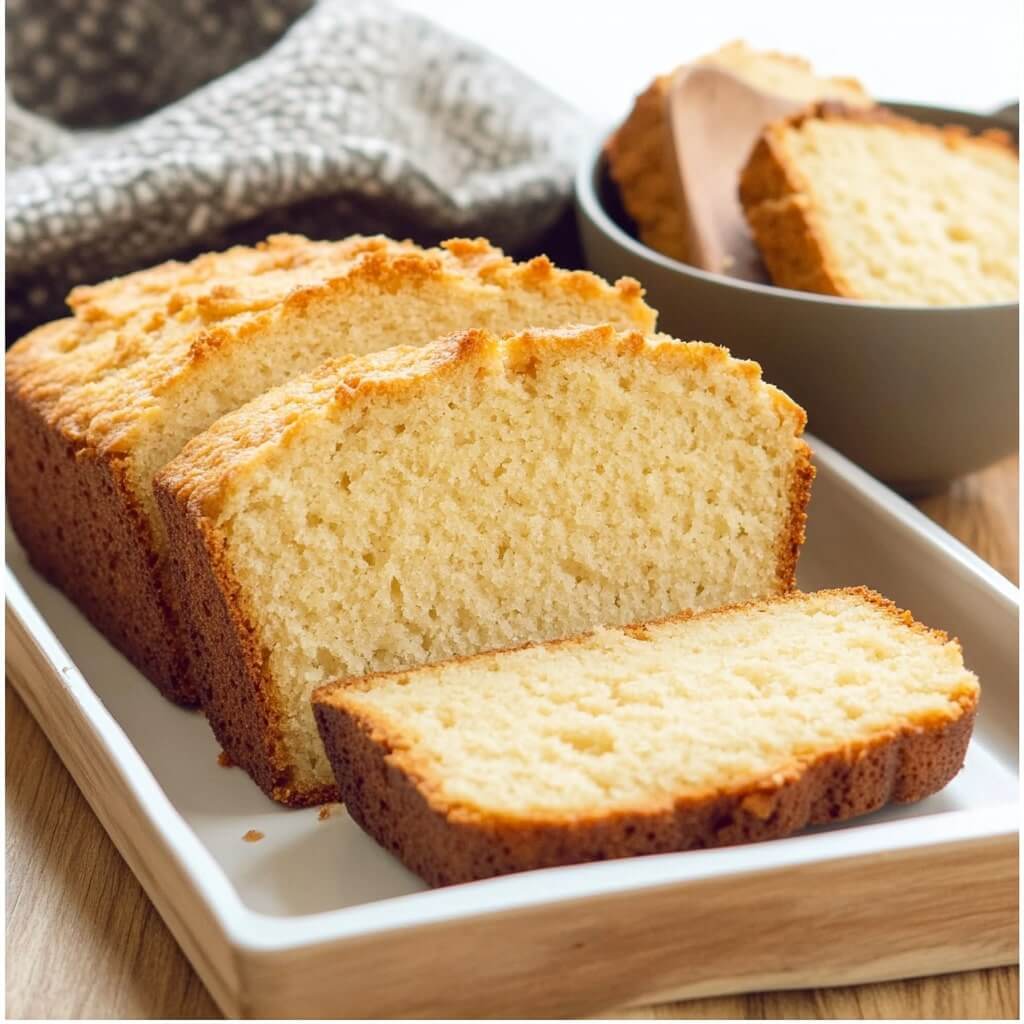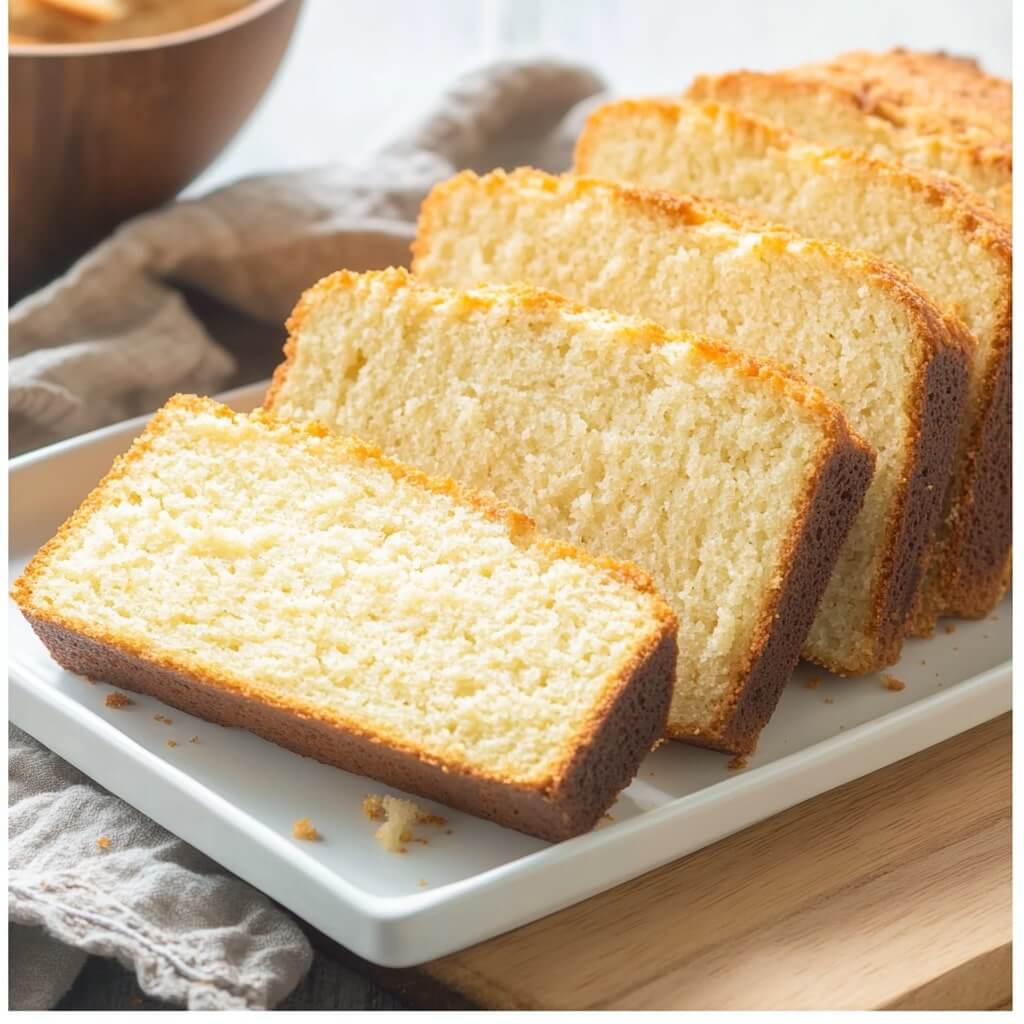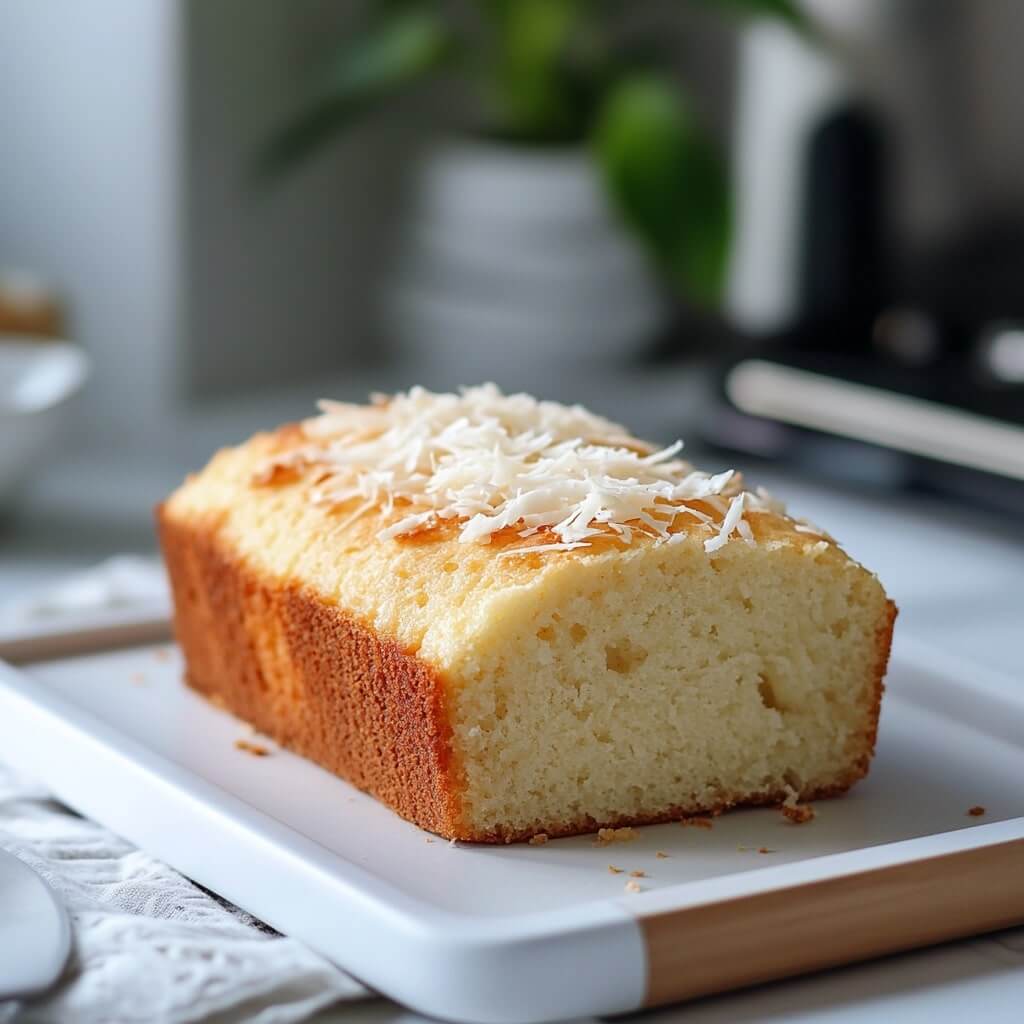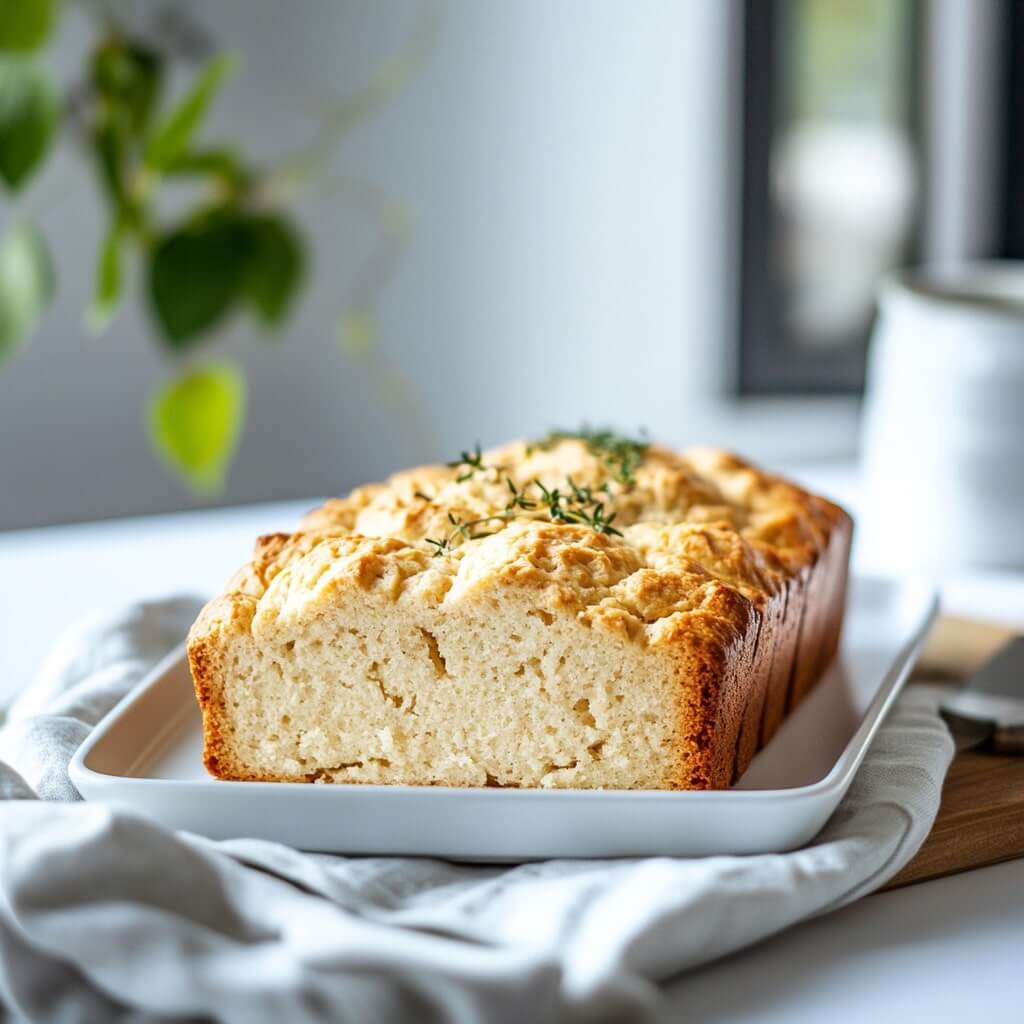If you’re following a keto diet or simply looking for a healthier, low-carb bread option, then this Coconut Flour Keto Bread recipe is a must-try. It’s light, fluffy, and savory, making it perfect for sandwiches, toast, or even as a side to your favorite dishes. This bread is a great addition to your low-carb lifestyle, and it will quickly become one of your go-to recipes for bread substitutes.
Why Choose Coconut Flour for Keto Bread?
Coconut flour is an excellent choice for keto bread due to its low carbohydrate content and high fiber content. Unlike traditional wheat flour, which is high in carbs, coconut flour provides a much lower carb alternative, making it ideal for those who are on a ketogenic or gluten-free diet. The added fiber in coconut flour also promotes better digestion and can help keep you feeling full longer.
Here are a few key benefits of using coconut flour in your keto bread:
- Low in Carbs: Coconut flour contains only about 4 grams of net carbs per 1/4 cup, making it a perfect choice for those limiting their carb intake.
- High in Fiber: Coconut flour is rich in fiber, which helps support digestive health and contributes to a feeling of fullness.
- Gluten-Free: It’s naturally gluten-free, which makes it a great alternative for people with gluten sensitivities or those following a gluten-free diet.
- Healthy Fats: Coconut flour contains healthy fats that are beneficial on a ketogenic diet, supporting energy levels and satiety.
Key Ingredients for Coconut Flour Keto Bread
This Coconut Flour Keto Bread recipe uses a handful of ingredients that work together to create a soft, flavorful loaf of bread. Here’s what you’ll need:
1. Coconut Flour
- The main ingredient in this recipe. It gives the bread its structure and texture while keeping it low-carb and gluten-free.
2. Whey Protein Isolate
- This adds structure and helps improve the texture of the bread, making it fluffier and more like traditional bread. It also adds a good amount of protein, which is important on a keto diet.
3. Eggs
- Eggs provide the necessary binding and structure for the bread. Coconut flour requires a higher egg-to-flour ratio than traditional flour-based recipes, which is why this bread uses 6 eggs.
4. Olive Oil
- Olive oil is used for moisture and richness. You can substitute it with avocado oil or melted butter for a different flavor profile.
5. Cheddar Cheese
- Grated cheddar cheese adds a savory flavor and helps bind the dough. It also makes the bread more flavorful and satisfying. You can skip the cheese or use dairy-free cheese if you prefer.
6. Baking Powder
- This ingredient is essential for helping the bread rise and achieve a fluffy texture.
7. Garlic Powder & Salt
- For a savory flavor, garlic powder and salt are added to enhance the bread’s taste.
8. Water
- The water helps bring the dough together. Coconut flour absorbs a lot of liquid, so you may need to adjust the water slightly depending on the consistency of the batter.
9. Optional Topping
- For added flavor and texture, you can top the bread with melted butter and everything bagel seasoning. This step is optional, but it gives the bread an extra punch of flavor.
Ingredients for Coconut Flour Keto Bread
- 2/3 cup (80g) coconut flour
- 1/2 cup (54g) whey protein isolate (or other protein powder of choice)
- 1 tbsp baking powder
- 3/4 tsp salt
- 3/4 tsp garlic powder
- 6 large eggs
- 1/3 cup (78.86 ml) olive oil (or melted butter, avocado oil can also be used)
- 6 ounces (170.1g) shredded cheddar cheese (or dairy-free cheese, optional)
- 1/4 cup (59.15 ml) water (you may need a little more depending on batter consistency)
- 1 tbsp melted butter (optional for brushing on top)
- 1 tsp Everything Bagel Seasoning (optional for topping)
Notes
Coconut Flour Absorption: Coconut flour is very absorbent, so you may need to adjust the water slightly depending on the humidity or brand of coconut flour you are using. If your batter feels too thick, simply add more water, one tablespoon at a time, until it reaches a scoopable and spreadable consistency.
Protein Powder Choices: While whey protein isolate works great for its texture-enhancing properties, you can substitute it with other protein powders. Egg white protein or pea protein are good alternatives, but they may alter the texture slightly. Avoid using collagen protein as it doesn’t provide the same structure for baking.
Eggs: Eggs are crucial for structure and texture in coconut flour bread, as they help hold everything together. Don’t skip or reduce the egg count.
Cheese Options: The shredded cheddar cheese adds both flavor and structure, helping the bread to hold together better. You can use other cheeses like mozzarella or parmesan for different flavors. For a dairy-free version, use dairy-free cheese or omit the cheese entirely.
Storage: The bread can be stored at room temperature for up to 4 days. For longer storage, refrigerate for up to 10 days or freeze slices for several months. Make sure to store it in an airtight container to keep it fresh.
Baking Tips: Check the bread around 25 minutes as oven temperatures may vary. The bread is done when it is golden brown on top and firm to the touch. To prevent over-baking, be sure to check the bread often as it gets close to being done.
Optional Topping: Brushing the bread with melted butter and sprinkling everything bagel seasoning on top gives the bread an extra layer of flavor. This is entirely optional but adds a nice touch for those who enjoy savory bread.
Step-by-Step Instructions for Making Coconut Flour Keto Bread
This recipe is simple and straightforward, making it a great option for those who want to enjoy homemade keto bread without the hassle. Here’s how you can make it:
Step 1: Preheat and Prepare the Pan
Preheat your oven to 350°F (175°C). Grease an 8×4 inch loaf pan with butter or oil, and line the bottom and long sides with parchment paper, leaving overhanging edges. This will help the bread release from the pan easily once it’s baked.
Step 2: Whisk the Dry Ingredients
In a large bowl, combine the coconut flour, whey protein isolate, baking powder, salt, and garlic powder. Whisk them together thoroughly to ensure there are no lumps, especially in the coconut flour. Coconut flour can clump up, so make sure to break up any clumps.
Step 3: Add the Wet Ingredients
Add the eggs, olive oil (or melted butter), grated cheddar cheese, and water to the dry ingredients. Stir until well combined. The dough should be thick but spreadable. If it’s too thick, add a little more water, one tablespoon at a time, until it reaches the desired consistency.
Step 4: Bake the Bread
Transfer the dough to the prepared loaf pan and spread it evenly. Bake in the preheated oven for 30 to 35 minutes, or until the top is firm to the touch. The bread should be golden brown on top, and when you lightly press it, it should spring back.
Step 5: Add the Topping (Optional)
Once the bread is baked, remove it from the oven. If you’d like, you can brush the top with melted butter and sprinkle everything bagel seasoning for added flavor. Return the bread to the oven for an additional 3 to 4 minutes to allow the topping to set.
Step 6: Cool and Slice
Let the bread cool in the pan for about 10 minutes, then lift it out using the parchment paper and place it on a cooling rack. Allow the bread to cool completely before slicing it into 16 even pieces.
Expert Tips for Perfect Coconut Flour Keto Bread
While this recipe is easy to follow, there are a few tips to ensure your Coconut Flour Keto Bread turns out perfectly every time:
- Use Fresh Ingredients: Make sure your coconut flour and protein powder are fresh. These ingredients can lose their effectiveness over time, which may affect the texture of your bread.
- Don’t Skip the Eggs: Coconut flour absorbs a lot of moisture, which is why eggs are crucial for providing structure and texture. Do not reduce the number of eggs in the recipe.
- Check the Bread Frequently: Oven temperatures can vary, so start checking the bread around the 25-minute mark. The bread is done when it’s golden brown on top and firm to the touch.
- Avoid Overmixing: When adding the wet ingredients to the dry, mix just until combined. Overmixing can make the bread dense.
- Storage: Store any leftover bread in an airtight container at room temperature for up to 4 days. You can also refrigerate it for up to 10 days or freeze it for longer storage.

Creative Ways to Enjoy Coconut Flour Keto Bread
Now that you have made your Coconut Flour Keto Bread, it’s time to get creative and explore all the delicious ways you can enjoy it. From simple toasted slices to full-on meals, this bread can easily become the base for many keto-friendly dishes. Here are some ideas to get you started:
1. Keto Avocado Toast
Avocado toast is a classic, and it’s easy to make keto-friendly with this Coconut Flour Keto Bread. Simply toast a slice of your freshly baked bread, then spread a generous layer of mashed avocado on top. You can season it with salt, pepper, and a drizzle of olive oil for extra flavor. For a protein boost, add a soft-boiled egg or sprinkle some chili flakes for a little heat.
2. Keto Sandwiches
Whether you’re making a traditional sandwich or something more creative, Coconut Flour Keto Bread is perfect for holding all your favorite fillings. Here are a few keto-friendly sandwich ideas:
- Turkey and Cheese: Layer slices of turkey, cheese, and some leafy greens for a filling sandwich.
- Chicken Salad: Combine chicken, mayo, celery, and a little mustard for a creamy and satisfying chicken salad sandwich.
- BLT: Bacon, lettuce, and tomato never go out of style. Add some avocado for a delicious twist on the classic BLT.
3. Keto Grilled Cheese
Craving a grilled cheese sandwich but don’t want to risk stepping out of ketosis? This Coconut Flour Keto Bread is the perfect base for a low-carb grilled cheese. Spread butter on the outside of two slices of bread, add your favorite cheese, and grill until golden and melty. Pair it with a bowl of keto-friendly tomato soup for a nostalgic meal.
4. Garlic Bread
Garlic bread is a keto favorite, and you can easily turn your Coconut Flour Keto Bread into a savory, garlicky delight. Spread a mixture of softened butter, garlic powder, and parsley over slices of the bread. Toast in the oven until crispy and golden for the perfect side dish to any keto meal, from pasta to a big green salad.
5. Keto French Toast
If you’re in the mood for a sweet breakfast, Keto French Toast is an excellent way to use your Coconut Flour Keto Bread. Dip slices of the bread in a mixture of beaten eggs, almond milk, vanilla extract, and cinnamon. Fry the slices until golden brown and top them with sugar-free syrup, fresh berries, or a dollop of whipped cream for an indulgent yet low-carb breakfast.
6. Coconut Flour Keto Bread Croutons
Need to add a little crunch to your keto salad or soup? Turn your Coconut Flour Keto Bread into croutons. Simply cut the bread into cubes, toss with olive oil and your favorite seasonings (like garlic powder, rosemary, and thyme), and bake in the oven until crispy. These croutons will add the perfect texture and flavor to any dish.
7. Keto Panini
Craving a delicious panini? You can easily make a keto-friendly version using your Coconut Flour Keto Bread. Layer your favorite deli meats, cheeses, and vegetables between slices of the bread, then grill the sandwich to crispy perfection. Whether you’re using turkey, ham, or roast beef, this keto panini is sure to satisfy your cravings.

How to Store Coconut Flour Keto Bread
Since this bread is made with coconut flour, it has a different shelf life compared to regular bread. Here are the best storage methods to keep your Coconut Flour Keto Bread fresh for longer:
1. Room Temperature Storage
- If you plan to eat the bread within a few days, you can store it at room temperature. Place the bread in an airtight container or wrap it tightly in plastic wrap to prevent it from drying out. It should stay fresh for up to 4 days when stored this way.
2. Refrigeration
- To keep your Coconut Flour Keto Bread fresh for up to 10 days, store it in the refrigerator. Wrap it in parchment paper and place it in an airtight container or a resealable bag. The cool temperature will help preserve the bread’s texture and prevent spoilage.
3. Freezing
- If you want to store the bread for a longer period, freezing is the best option. Slice the bread before freezing, so you can easily grab a slice whenever you want. Place the slices in a freezer-safe bag or airtight container, making sure to remove as much air as possible. The bread can be frozen for several months. To thaw, simply let it sit at room temperature or toast it directly from the freezer.
Troubleshooting and Tips for the Perfect Coconut Flour Keto Bread
While this recipe is simple, there are a few common issues that can arise when working with coconut flour. Here are some troubleshooting tips to ensure your bread turns out perfect every time:
1. Dense Bread
- Coconut flour can absorb a lot of liquid, which may lead to a dense loaf if not enough liquid is added. If your batter seems too thick, add an extra tablespoon of water at a time until the batter reaches a scoopable consistency.
- Another tip is to use a lighter protein powder, as some protein powders can make the bread denser. Opt for a whey protein isolate or egg white protein powder for a fluffier texture.
2. Bread Not Rising
- Coconut flour bread doesn’t rise in the same way as wheat bread, so you may not get the same height. However, if the bread is not rising as expected, check that your baking powder is fresh. Expired baking powder can affect the rise of your bread.
3. Too Dry or Crumbly
- Coconut flour absorbs a lot of moisture, and if you don’t have enough moisture in the dough, the bread may end up too dry or crumbly. Be sure to use the correct amount of eggs and oil to create the right balance of moisture and structure.
- If the bread is too dry after baking, you can brush the top with some melted butter or olive oil to add moisture and enhance the flavor.
4. Uneven Baking
- To prevent uneven baking, make sure to spread the batter evenly in the pan and check the bread frequently during baking. Every oven is different, so your bread may take a few extra minutes to bake. The best way to check for doneness is to lightly press the top of the bread – if it feels firm to the touch, it’s ready.
Why Coconut Flour Keto Bread is a Game Changer for Your Diet
Coconut Flour Keto Bread is a game changer for anyone on a low-carb or ketogenic diet. It offers a delicious, healthy alternative to traditional bread without the high carbs and gluten. The combination of coconut flour, protein powder, and eggs creates a light and fluffy loaf that can be used for sandwiches, toast, and more. It’s perfect for those who want to enjoy the taste and texture of bread without the guilt.
This bread is not only low in carbs but also packed with healthy fats and protein, making it a great addition to your keto meals. Plus, it’s versatile enough to be used in a variety of dishes, from savory sandwiches to sweet French toast. Whether you’re following a keto diet or simply looking for a healthier bread alternative, this Coconut Flour Keto Bread recipe is a must-try.

Tips for Customizing Coconut Flour Keto Bread
While this Coconut Flour Keto Bread recipe is fantastic as is, the beauty of homemade bread is that it’s easy to customize. With just a few tweaks to the ingredients, you can make variations that suit your specific tastes or dietary needs. Here are some ideas for making the bread your own:
1. Sweet Variations
If you’re looking for a slightly sweeter version of this bread, consider adding a low-carb sweetener like erythritol, monk fruit, or stevia to the batter. Here are a few options:
- Cinnamon Swirl: Add 1 to 2 teaspoons of cinnamon to the batter for a warm, spiced flavor. For a cinnamon swirl effect, mix cinnamon and a little sweetener together and swirl it into the dough before baking.
- Vanilla Flavor: Adding 1 teaspoon of vanilla extract can give the bread a sweet, comforting flavor without adding any sugar.
- Sweetened with Low-Carb Sweeteners: Adjust the amount of sweetener to your preference. Erythritol, monk fruit, or a blend of both work well in keeping the bread sweet but low in carbs.
2. Savory Additions
If you prefer a more savory bread, here are a few ideas to make your Coconut Flour Keto Bread extra flavorful:
- Herbs and Spices: Add dried herbs like rosemary, thyme, or oregano to the dough for a herbed bread perfect for pairing with soups or salads.
- Cheese Varieties: While this recipe calls for cheddar, you can substitute with other cheeses like mozzarella, parmesan, or even goat cheese for different flavor profiles.
- Sun-Dried Tomatoes or Olives: Chopped sun-dried tomatoes or olives can be added to the batter for an extra burst of flavor.
3. Nutrient Boosters
Coconut flour is already nutrient-dense, but you can add even more nutrients to your bread by incorporating some of these ingredients:
- Chia Seeds or Flaxseeds: Both chia and flaxseeds are rich in fiber and omega-3 fatty acids. They can be mixed into the dough for a nutritional boost while adding some extra texture.
- Psyllium Husk Powder: This ingredient is often used in keto bread recipes to help improve texture and moisture retention. It also adds extra fiber to your bread.
4. Dairy-Free Version
If you’re looking for a dairy-free alternative to this bread, it’s easy to make adjustments:
- Cheese: Use dairy-free cheese or omit it altogether.
- Butter: Substitute the butter with coconut oil, olive oil, or avocado oil for a dairy-free fat option.
- Egg Substitute: If you have an egg allergy or are following a plant-based diet, you can substitute eggs with a flax egg (1 tablespoon ground flaxseed mixed with 3 tablespoons of water) for each egg.
5. Use Different Protein Powders
The original recipe uses whey protein isolate, but there are other protein powders that work well in coconut flour bread recipes. Here are some alternatives:
- Egg White Protein: This is a great alternative to whey protein if you’re looking for a dairy-free option. It provides a similar texture but can sometimes make the bread a bit drier.
- Pea Protein: Pea protein is another dairy-free option and can work well in this recipe. It’s a bit more neutral in flavor and can give your bread a good rise.
- Collagen Protein: Though collagen protein is great for skin, joints, and hair, it doesn’t provide the structure needed for bread, so it’s best avoided in this recipe.
Nutritional Breakdown of Coconut Flour Keto Bread
For those who are counting macros and keeping track of their nutritional intake, here’s a detailed nutritional breakdown of a slice of this Coconut Flour Keto Bread:
| Nutrient | Amount per Serving |
|---|---|
| Calories | 141 kcal |
| Total Carbohydrates | 3.29g |
| Net Carbs | 1.6g |
| Protein | 8.2g |
| Fat | 9.8g |
| Fiber | 1.7g |
| Sugar | 0g |
| Cholesterol | 37mg |
| Sodium | 198mg |
This breakdown shows that the bread is packed with protein and healthy fats, making it a filling and nutritious addition to your keto diet. The net carbs per slice are incredibly low, making it ideal for those who need to stay within strict carb limits.

FAQ: Coconut Flour Keto Bread Recipe
1. Is Coconut Flour Ok for a Keto Diet?
Yes, coconut flour is an excellent choice for a keto diet. It is low in carbohydrates and high in fiber, which makes it a perfect substitute for high-carb flours like wheat or all-purpose flour. Coconut flour has about 4 grams of net carbs per 1/4 cup, making it ideal for those who need to maintain a low-carb lifestyle. It is also gluten-free, making it a great option for individuals who have gluten sensitivities.
2. Is Coconut Bread Keto Friendly?
Yes, coconut flour bread can definitely be keto-friendly. When made with low-carb ingredients like coconut flour, eggs, and healthy fats (like olive oil or butter), coconut bread fits perfectly into a keto diet. Coconut flour is low in carbs and high in fiber, making it a great alternative to traditional bread that’s high in carbohydrates. Just be sure to avoid adding sugary ingredients, as they can increase the carb count and make it non-keto.
3. Does Yeast Work with Coconut Flour?
No, yeast doesn’t work well with coconut flour. Coconut flour lacks gluten, which is essential for yeast to rise and create the texture needed for traditional yeast bread. While you can use coconut flour to make quick breads (which don’t require yeast), you won’t be able to make a traditional yeast bread using coconut flour. If you’re looking for bread that rises like traditional bread, you’ll need to rely on alternative leavening agents like baking powder or baking soda instead of yeast.
4. Can I make this coconut flour keto bread recipe sweeter?
For sure! If you want a sweeter loaf, especially for something like a keto banana bread recipe with coconut flour, you can add a bit of your favorite keto sweetener—like monk fruit or stevia. I personally love the combo of ripe bananas and a little cinnamon to bring out the sweetness. And if you’re feeling adventurous, toss in some sugar-free chocolate chips for a delicious twist!
5. Is there a way to make coconut flour keto bread fluffier?
Yes! To make the bread fluffier, you can try mixing coconut flour with almond flour, like in a keto bread recipe almond and coconut flour combo. This creates a lighter, airier loaf while still keeping it low-carb. Another tip is to ensure you’re using the right leavening agents, like baking powder and xanthan gum, which help the bread rise properly and maintain its structure.
6. Can I make this coconut flour keto bread in a bread machine?
Absolutely! If you’re not in the mood to bake by hand, a keto coconut flour bread machine recipe is a total time-saver. Just follow the bread machine’s instructions, and you’ll have a perfectly baked loaf with minimal effort. The key is to check your machine’s settings for keto-friendly dough and adjust as needed, but it’s an easy way to get your bread on the table without the mess.
7. How do I store coconut flour keto bread to keep it fresh?
Great question! To keep your coconut flour keto bread fresh, store it in an airtight container at room temperature for up to 3 days. If you want it to last longer, slice it up and freeze individual slices. That way, you can grab a slice whenever you need it! This works especially well if you’re making keto bread with coconut flour in a bread machine and want to store some for later.
8. Can I customize my coconut flour keto bread with other ingredients?
Oh, yes! That’s one of the best parts of this recipe. You can add a variety of things to make it your own. For a savory twist, try adding garlic, herbs, or even cheese. If you’re craving something nutty, toss in some flaxseeds, sunflower seeds, or chopped nuts. I’ve even added a few tablespoons of cinnamon to create a comforting, spiced loaf. The possibilities are endless—get creative!
Conclusion
Making your own coconut flour keto bread recipe is honestly one of the best decisions you can make if you’re following a low-carb lifestyle. It’s a simple, beginner-friendly recipe that’s not only delicious but also incredibly versatile. Whether you’re craving something sweet, like a keto banana bread recipe with coconut flour, or prefer a savory twist, this recipe has your back. And with a few easy swaps, you can create a loaf that suits your taste every single time.
Personally, I’ve been hooked on making this bread over and over. The texture is just spot on—soft, fluffy, and perfect for any meal. I love how you can customize it with different add-ins like cheese or spices, and even play around with sweet options like banana bread. You don’t need to be an expert baker to pull it off, and it’s a great way to stay on track with your keto goals without missing out on that comforting bread texture we all love.
I really encourage you to give this coconut flour keto bread recipe a try. It’s an absolute game-changer for your keto journey! Plus, once you get the hang of it, you can start experimenting with other variations—maybe a keto coconut flour bread machine recipe or a hybrid with almond flour for a fluffier loaf. Whatever you choose, I’m sure you’ll find it just as satisfying as I do.
So, grab your ingredients, preheat that oven, and get ready to bake something amazing. I’d love to hear how your bread turns out—drop a comment below and share your experiences. Let’s keep the keto bread creativity flowing! Happy baking! 🌿🍞






